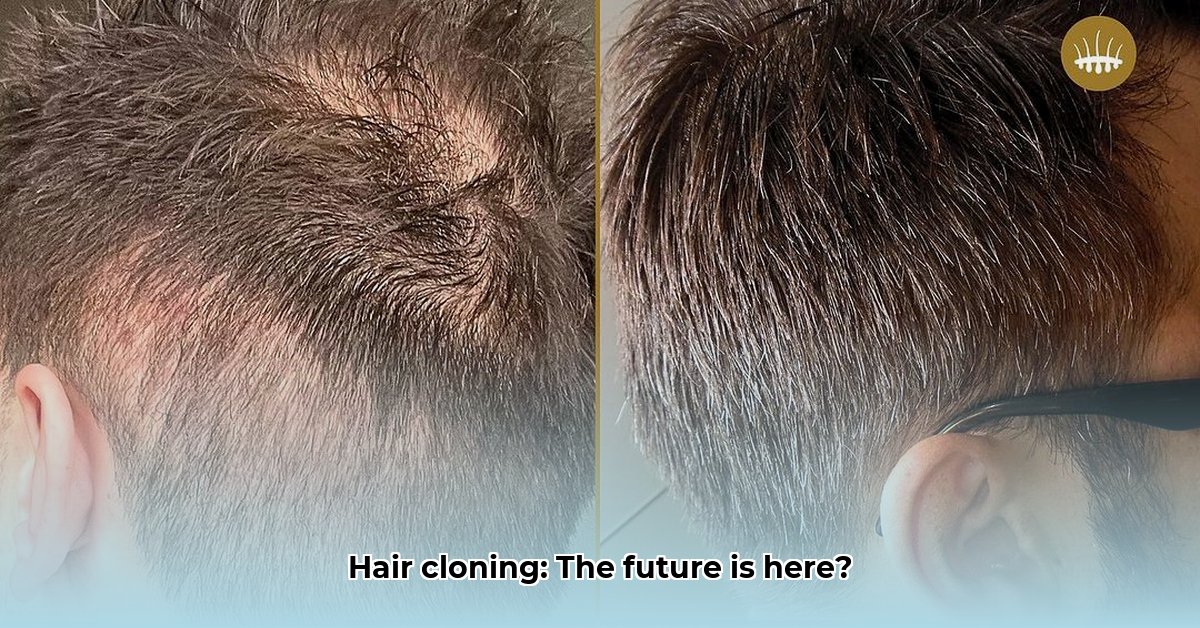For years, a permanent fix for hair loss has been a sought-after dream. Now, in 2025, we are closer than ever to making that dream a reality. While creating entirely new hair follicles from scratch remains in the realm of science fiction, amazing progress in growing new hair offers hope to those dealing with thinning hair or baldness (alopecia). For natural hair color options, see henna hair dye options. This article unpacks the latest breakthroughs in hair regeneration, explains different methods, includes insights from top scientists, and shares tips to keep your hair healthy. We will cover the advancements, acknowledge the limitations, focus on proven ways to regrow hair, and give practical advice on today’s hair loss treatments.
Hair Cloning: Unlocking Hair Regeneration in 2025
Let’s discuss the possibilities and limitations surrounding hair regeneration. The idea of “hair cloning” – creating entirely new hair follicles – is still futuristic. However, we’re making significant progress in growing and transplanting hair follicles, offering hope for those dealing with hair loss. What are the current advancements and can they provide a better solution than traditional procedures?
Growing Your Own Hair: Current Advancements in Hair Regeneration Techniques
The most promising research focuses on multiplying hair follicle cells. Scientists are proficient at growing these cells in a lab – in petri dishes – and then replanting them into the scalp. This approach is a game-changer compared to traditional hair transplants, which are limited by the number of follicles you can take from another area of your scalp. This opens the door to vastly increasing your supply of hair follicles.
Researchers are reporting success using cells from both mice and humans. Companies are launching clinical trials – the testing required before treatments are available. It’s a slow process, but progress is being made and promising results are emerging from these testing phases. What factors are most important when considering hair regeneration treatments?
The Challenges: Scaling Hair Regeneration from Lab to Your Head
Achieving survival and thriving of new hair follicles after transplantation poses a hurdle. These delicate cells are tricky to work with. Creating a reliable method that consistently produces healthy follicles is another challenge. Ensuring enough production to effectively treat significant hair loss is essential. Getting regulatory approval is a long and complex process, requiring testing to prove safety and effectiveness. How can these challenges be overcome to make hair regeneration more accessible?
The Possibilities: MicroRNAs and Future Hair Regeneration Breakthroughs
Exciting new research focuses on microRNAs – tiny molecules that control how our genes work. Published in the journal Nature, researchers at Northwestern University found that stiffening of hair follicles as people age makes hair more difficult to grow. Their study reports they found a way to grow hair in mice by softening the stem cells by boosting the production of a tiny RNA particle (miR-205) that relaxes the stiffness of the cells. Human trials are planned to see if these results translate to people. This is early-stage research, but the potential is huge. Could this be the key to a real hair cloning breakthrough that utilizes future regenerative medicine?
HairClone: Follicle Banking for Future Treatments
HairClone, a UK-based company, offers a unique service: follicle banking. They store your extracted hair follicles at -150C, with the intent that these follicles can be multiplied in the future to treat hair loss. While the treatments aren’t available yet, follicle banking provides an option to consider.
Stemson Therapeutics: Engineered Follicular Units
Stemson Therapeutics is advancing its proprietary hair rejuvenation solution, using engineered follicular units. According to industry experts Stemson Therapeutics aim to begin human clinical trials by 2026, which could bring the technology closer to real-world applications.
Aderans Research Institute: Cell Therapy System
Aderans Research Institute has conducted Phase 2 clinical testing on a cell therapy system that rejuvenates shrinking hair follicles. Initial data suggest this approach can safely produce durable hair growth.
A Practical Framework: Steps for People and Researchers
For People Experiencing Hair Loss:
- Explore Existing Options: Start with what’s available now. Treatments like minoxidil and finasteride, or even traditional hair transplants, can offer some help.
- Consider Follicle Banking: Storing your hair follicles now might mean having a source of cells for future, more advanced treatments.
- Stay Informed: Keep an eye on research developments and clinical trials. New and better treatments are likely on the horizon.
- Consult a Dermatologist: Talk to a dermatologist or hair loss specialist to determine the cause of your hair loss and get personalized recommendations.
- Manage Stress: High stress levels can contribute to hair loss. Incorporate stress-reducing activities like exercise, meditation, or yoga into your routine.
For Researchers and Biotech Companies:
- Improve Cell Culture: There is a need for better methods to keep hair follicle cells healthy and growing in the lab.
- Rigorous Testing: More human clinical trials are essential to prove that these technologies are both safe and effective.
- Prepare for Production: Consider how these treatments will be made and distributed on a large scale.
- Navigate Regulations: The process of getting regulatory approval is complex and demanding.
- Focus on Long-Term Efficacy: Conduct studies that monitor hair growth and follicle health over extended periods to ensure lasting results.
- Address Safety Concerns: Thoroughly investigate potential side effects and develop strategies to minimize risks.
- Standardize Procedures: Establish standardized protocols for cell extraction, culture, and transplantation to ensure consistent outcomes.
Weighing the Risks: Pros, Cons, and Limitations of Hair Regeneration Treatments
Here is a concise comparison of the short-term and long-term risks associated with various hair regeneration strategies. It’s important to note that long-term risks are currently unknown for some technologies.
| Technology | Short-Term Risks | Long-Term Risks |
|---|---|---|
| Cell-Based Regeneration | Low cell survival, inconsistent follicle production | Unknown long-term effects, potential for tumor growth, high cost, potential for scarring. |
| MicroRNA Manipulation | Potential skin irritation, unforeseen side effects | Unknown long-term effects on hair follicle health. |
| Traditional Hair Transplant | Scarring, infection, unnatural appearance, pain | Limited supply of donor follicles, high cost. |
| Follicle Banking | Cost of storage, no guarantee of future treatment success | Uncertainty about the long-term viability of stored follicles. |
The Bottom Line: Hope On The Horizon of Regenerative Medicine
The future of hair regeneration is promising. While complete hair cloning is still distant, advancements in hair loss treatments are being made. The next few years will be vital in moving promising lab results into real-world applications. How will these breakthroughs revolutionize hair loss treatments?
Choosing the Best Hair Follicle Regeneration Clinic: A Comprehensive Guide
Key Takeaways:
- Hair follicle regeneration is an evolving field with varying results.
- Current FDA-approved hair restoration methods primarily involve hair transplantation, not cloning.
- Choosing between hair regeneration clinics requires research and consideration.
- Be wary of clinics making unrealistic claims or offering unproven therapies; transparency and ethical conduct are essential.
Hair Cloning: Separating Science Fact from Science Fiction
Hair cloning conjures images of futuristic laboratories churning out locks on demand. The reality is more nuanced. While true hair cloning remains largely experimental, significant progress has been made in cultivating and manipulating existing follicles. These techniques, including follicle cloning (HairClone), follicle neogenesis, and stem cell-based therapies, offer possibilities for hair restoration. What factors should you consider when differentiating between science and sensationalism?
Current Advances and Limitations of Hair Regeneration Techniques
In-vitro cultivation of hair follicles is now possible, a major scientific achievement. This process involves growing follicles in a lab setting, allowing for manipulation and potential multiplication. Growing follicles in the lab is one thing; successfully transplanting and nurturing them to achieve long-term, natural-looking hair growth is another. The success hinges on the quality of the donor follicles, their age greatly influencing efficacy. Most breakthroughs are still under investigation and much remains unknown about their long-term efficacy and potential side effects. Rigorous clinical trials are crucial before these technologies become widespread. How can prospective patients better understand the limitations and breakthroughs?
Separating Fact from Fiction in Hair Restoration: What to Expect
It’s important to differentiate between genuine scientific advancements and exaggerated claims. Hair transplantation—moving existing hair follicles from one area to another—is a proven, FDA-approved method. Hair cloning is largely in the experimental phase, with varying success rates across studies. Clinics might use “hair cloning” loosely to describe other techniques, such as stem cell therapy or follicle neogenesis. Make sure the clinic clearly defines their specific method.
Selecting the Right Clinic: Hair Follicle Regeneration Techniques
Choosing a clinic for hair restoration or experimental therapy demands careful consideration. A step-by-step approach is crucial:
- Verify Credentials: Ensure the clinic and practitioners are licensed and board-certified. Check online reviews and professional organizations to verify their legitimacy.
- Examine their Methodology: Inquire about the procedures offered. Do they clearly explain their methods? Do they use FDA-approved treatments?
- Assess Transparency: A clinic will openly discuss potential benefits, risks, limitations, and costs associated with each procedure while avoiding unrealistic promises. Scrutinize before-and-after photos.
- Seek Multiple Consultations: Obtain consultations from several clinics to compare their
- Achieve Anesthesiology Work-Life Balance: Your Guide - December 4, 2025
- Unlock Young Doctors’ Work-Life Balance: Actionable Strategies Now - December 2, 2025
- Unlock Life Harmony: Work-Life Integration Guide - November 30, 2025
















